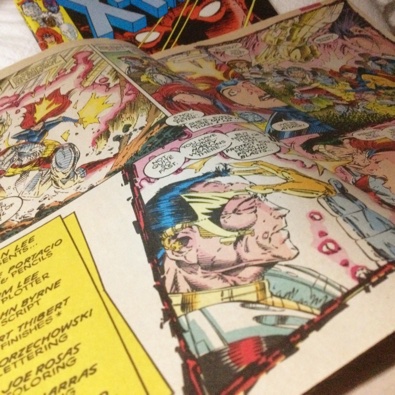
Photo: The Uncanny X-Men Volume 1, No. 285 “Portal’s End”
I stumbled upon a two page-spread that spanned the second and third pages, while flipping through an X-Men comic book from the nineties that I picked up from a local thrift. The comic doubled as a splash page listing all the script writers, letterers, inkers, colorists, and producers of the entire comic book.
The most interesting part was how it altered the way my eyes moved around the page as I was reading it. Instead of scrolling through the entirety of page two and then moving my eyes from the top to bottom of page three, I first allowed myself to take in all the details of the two pages side-by-side and figure out the comic’s natural order.
The two page comic spread made me think about its digital counterpart, which would either be a full-screen presentation of a double page shown side-by-side, or two separate pictures uploaded on two different days with an anticipation for a printed version where the viewer could finally see the two-pages printed next to each other. It reminded me about collecting trading cards that required two separate cards to complete a set and make a whole picture.
Two-page comic layouts make the most sense for printed comic layouts, whereas the impact of a two-page spread is limited by screen size. Printed comics have an advantage in presenting comic layouts the way they were originally intended.
.::.
What's Quacking?
Do you have any original art to contribute to our stock image database, announcements, community projects, ideas, news, or milestones to report? Please leave general comments below or send a PQ to kawaiidaigakusei. Email me at kawaiidaigakusei(at)gmail(dot)com.

Spreading Out the Two-Page Layout
kawaiidaigakusei at 12:00AM, Oct. 18, 2021
6 likes!


©2011 WOWIO, Inc. All Rights Reserved Mastodon





hushicho at 5:24PM, Oct. 19, 2021
Those can be so fun, though they must be very judicious in their uses. It's easy to rely too much on splashes for drama or to showcase art skills, though they often take longer than regular panel art if they're done well. I still love Wally Wood's 22 panels that always work, because it's true. They do!
cdmalcolm1 at 4:56AM, Oct. 19, 2021
I think Jim Lee handles splash pages well. As much as the writer can view a take on how the story should flow, Jim to me kind of takes over the flow then gives you a different experience with storyboarding. I get what marcorossi and Banes is saying. I feel that with doing digital Scrolling comics. The feel to me is the same. I have seen very poor attempts of printed comics converted into scrollers. When they get to a two page splash, the whole feel of the storyboard collapse. With that being said, printed comics conversions to fit digital formats of various types gets lost in storytelling. If you plan on doing a conversion to digital,(especially scrollers), Just re-draw them over to fit said format of the digital realm.
Banes at 3:13PM, Oct. 18, 2021
My favourite double page spectacular was in Hulk: Future Imperfect (great story) with the reveal, in an alternate future, of old Rick’s museum/memorial of all the deceased heroes. It’s a big treasure hunt, letting readers look around and spot all the remains/props left from the various characters (including some fun non-marvel Easter eggs of course). Drawn by George Perez.
marcorossi at 8:03AM, Oct. 18, 2021
Looking more at the image of the post, you aren't speaking of a single image that spans two pages, but pictures that are disposed on two pages as if it was one. I don't see the point of doing this, it seems to me that it's weird for weird sake. Yeah everyone loves me at parties.
marcorossi at 8:00AM, Oct. 18, 2021
Boo to two pagers! I think that two pagers, and in fact even a single splash page, usually are a bit overkill. If one generally draws 5/6 pictures per pages, and then draws one page with a picture that takes the space of 3/4 normal pictures, this already gives the effect of "very important moment" that comes from splash pages. If on the other hand one uses big pictures very often, even in points of the plot where what is happening isn't very important, then s/he'll have to use splash pages or double pages to make the difference. It is a bit like using bold on every sentence of a text, if you fill the text with bolds nobody will notice them anymore and you'll have to use even bigger effects and so on and on.
plymayer at 5:48AM, Oct. 18, 2021
Two pagers can be great when used appropriately in print comics. Jack Kirby did them well. Modern comics over use them to the point that they are a cheat to fill up the pages.
KAM at 4:47AM, Oct. 18, 2021
I think the first double-page spread actually appeared in a late 1930s comic. I've come across a few reading scans at public domain comic hosting sites the Digital Comic Museum and Comic Book Plus. My favorite artist, Mike Grell, did them in most issues his comic The Warlord & I think his later books as well. Phil Foglio uses them in Girl Genius & he explains to his webreaders that they're seeing half of a double-page spread & when the second page goes up he has a link to the image as one picture. What's nice is he realizes that the first-time readers will only be seeing one page at a time so he doesn't have a word balloon go across the whole page or have characters on one side having a conversation with characters on the other side.